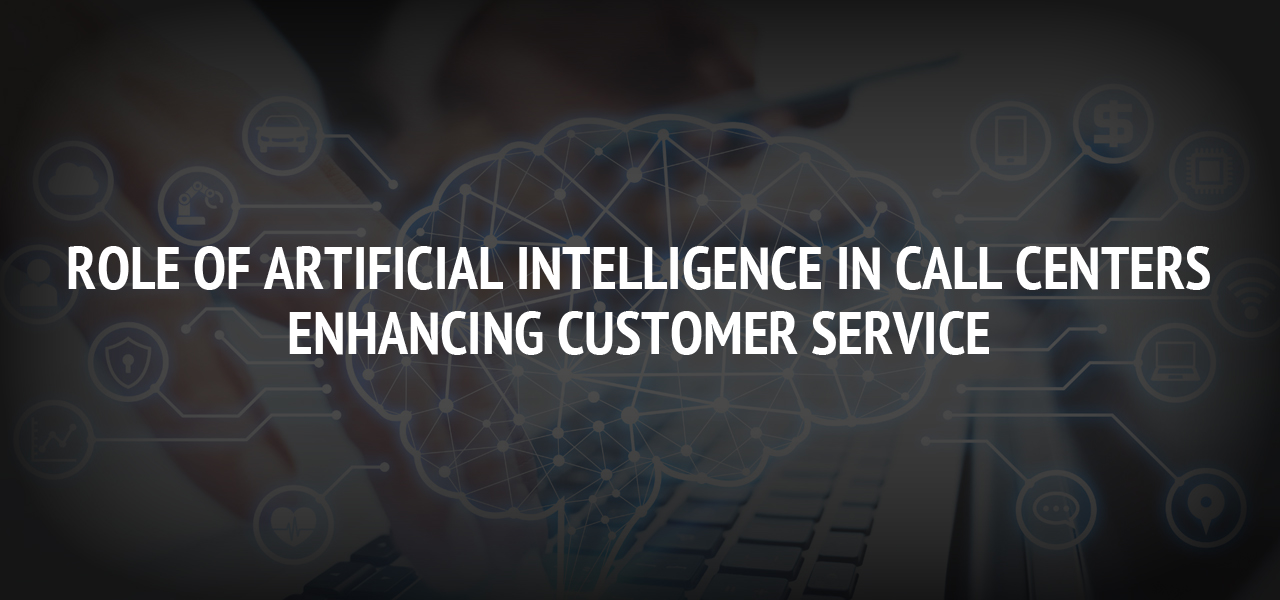Role of Artificial Intelligence in Call Centers: Enhancing Customer Service

AI could improve customer service in a call center by making it more efficient and reducing the time it takes to respond. One of the most common ways AI is used in call centers is to power chatbots. These chatbots mimic human communication using natural language processing (NLP) algorithms.
It can help your human workers answer customer calls more quickly by listening to the conversation and giving important information immediately. The technology works in the background to get helpful information from the exchange or to provide the customer with a few choices based on their needs.
The Use of AI in Enhancing Customer Service
AI is expected to make businesses up to 40% more productive by 2035. With AI-powered customer service, you can learn more about your customers and improve their experience. This improves the online customer experience, customer retention rate, company image, preventive care, and money made.
AI could also work with human help agents to do simple tasks so that humans can focus on more complex problems. AI technologies like chatbots can understand speech triggers and give the correct information and directions without the need for human workers.
AI can also be used in customer service by collecting and analyzing data. Communication with customers creates massive data that can tell you much about their behavior, tastes, rate of leaving. Learn more about AI dubbing here.

Latest Trends in the Role of AI in Call Centers
Predictive Analytics
Predictive analytics can help call centers provide proactive support. Call centers can provide personalized and timely customer support by analyzing customer data and predicting customer behavior. According to a study, the predictive analytics market will reach $10.95 billion by 2026.
Artificial intelligence (AI) has been applied to contact center solutions to improve customer support. These AI tools can handle basic customer inquiries and requests, freeing human employees to address more complex issues.
Chatbots
AI-powered virtual assistants can handle routine customer inquiries and provide quick and efficient support.The Grand View Research study shows the demand for 24/7 customer support will drive the chatbot market to $9.4 billion by 2024.
Voice Analytics
AI-powered voice analytics can help call center agents analyze customer conversations in real-time and provide insights into customer sentiment and behavior. According to a study by MarketsandMarkets, the voice analytics market is expected to reach $1.64 billion by 2025.
Intelligent Routing
AI-powered intelligent routing can help call centers route customer inquiries to the most appropriate agent based on their skills and availability. This can decrease waiting time and improve the overall customer experience
Sentiment Analysis
Sentiment analysis can help call center agents understand customer emotions and provide more empathetic support. By analyzing customer conversations and identifying emotions such as frustration or satisfaction, call center agents can tailor their responses to meet customer needs better. According to Zion Market Research, sentiment analysis is expected to reach $11.5 billion by 2025.
As the world of AI technology continues to grow and evolve, you can expect to see even more innovative applications of AI in call centers in the future.
Steps In Enhancing Customer Services Using AI In Call Center Industries
Call centers are the primary contact between a business and its customers. Customer service is essential to any successful business.
Here are steps in enhancing customer services using AI in call center industries.
Change how calls are routed.
The smoother the buying process because of AI, the more likely the purchase will go through. For example, AI makes looking at a customer's browsing past on a company's website effortless to determine what they want and help them find it.
It also makes proactive support easier, so companies can find customer problems quickly, sometimes before the customers even know they have them. With this kind of method, getting leads is always accessible.
Streamlines how things work.
You can count on your AI assistant to answer most of your questions. Chatbots keep track of what customers do and can answer frequently asked questions, help find items left in shopping carts, help with checkout, and more. Even if a robot can't solve a problem, sending the customer to a natural person is easy.
Facilitates great customer service
As AI gets smarter, customer service bots are becoming very good at learning quickly. An AI bot can collect valuable information about customers and make them happier, which leads to better customer service. Some things that improve the customer experience and make customers more loyal are personalized and targeted help, quick response times, 24/7 availability, and support in multiple languages.
Saves budget
As your business grows, it will cost less to use AI for customer service than to hire more reps. Even simple jobs can be done with free AI tools. The price of a chatbot changes from device to implementation so that each business can find the best option. Overall, if you want to use AI for customer service, you don't have to spend a lot of money on it at first.
It keeps workers from getting tired of their jobs.
AI customer service can work all the time to help and even replace human teams when needed. That means that robots can only replace some human workers. It means that AI can help people do simple jobs and give them a good balance between work and life.

Advantages of Artificial Intelligence ( AI) in a Call Center Industry
Today, artificial intelligence is becoming more common in many areas. Switching call centers to AI has essential benefits from the beginning to the end. Now let's look at these pros.
Customer Service Got Better
AI-powered call centers can improve customer service by using the natural language processing (NLP) and machine learning (ML) to understand what the customer means and react in real time. Chatbots and virtual helpers can immediately help customers and answer their questions around the clock. This cuts down on the time people have to wait and ensures they get the information they need quickly.
Better use of time
AI can handle repetitive tasks like call routing, call logging, and meeting scheduling so that agents can focus on more complicated tasks. AI can also listen to and analyze call data, looking for trends and giving agents information that can help them handle calls better.
Getting costs down
AI-powered call centers can improve efficiency and cut labor costs, saving companies money. Agents need more work because chatbots and virtual assistants can handle simple questions and chores. This means businesses can hire fewer agents and save money on salaries and perks.
Analytics for the Future
AI can look at vast amounts of data to find patterns and guess what will happen in the future. Predictive analytics can help call centers determine which customers are likely to leave and take steps to keep them. They can also use predictive analytics to guess what customers want and give them personalized suggestions, improving the customer experience.
Checking on quality
AI can listen in on calls in real time, find places to improve, and let workers know about it. This can help workers improve their work and give better service to customers. AI can also find patterns in what customers say, which can help businesses make their goods and services better.
Frequently Asked Questions
How does AI help with handling calls?
Answer: AI can help with call routing by using data analytics to predict customer wants and preferences. This lets calls be sent to the best agent or department for the best customer experience.
How does AI help with quality control?
Answer: AI can help with quality assurance by watching and analyzing how agents deal with customers to find places where they could do better and give them feedback and training to help them do so.
What could be some of the problems with using AI in call centers?
Answer: There could be problems with using AI in call centers, such as the risk of losing the human touch, the chance of computer glitches or mistakes, and the need for ongoing training and development to keep up with how technology is changing.
Conclusions
Artificial intelligence (AI) has a significant role in call centers to improve customer service. AI tools, like chatbots, virtual assistants, and speech recognition systems, have made customer transactions faster and more accurate while cutting down on wait times.
With AI, call centers can customize the experience for each customer, automate routine jobs, and make agents more productive. As AI technology keeps improving, it will become an even more critical part of how customer service in call centers is done in the future.
About The Author
Related Blog
View All-
Tools for Starting Your Own Business
Starting your own business is an exciting venture that requires careful planning, management, and strategy. Today's digital landscape offers a myriad of tools to help entrepreneurs streamline operations, manage finances, and enhance customer engagement. From ...
-
Must-Have Apps for the International Freelance Worker
Having the right tools is very important for any freelancer to produce his best work. As a freelancer, you have to manage different tasks, work expenditure and productivity all by yourself. However to do your freelancing job successfully it is important to make ...







